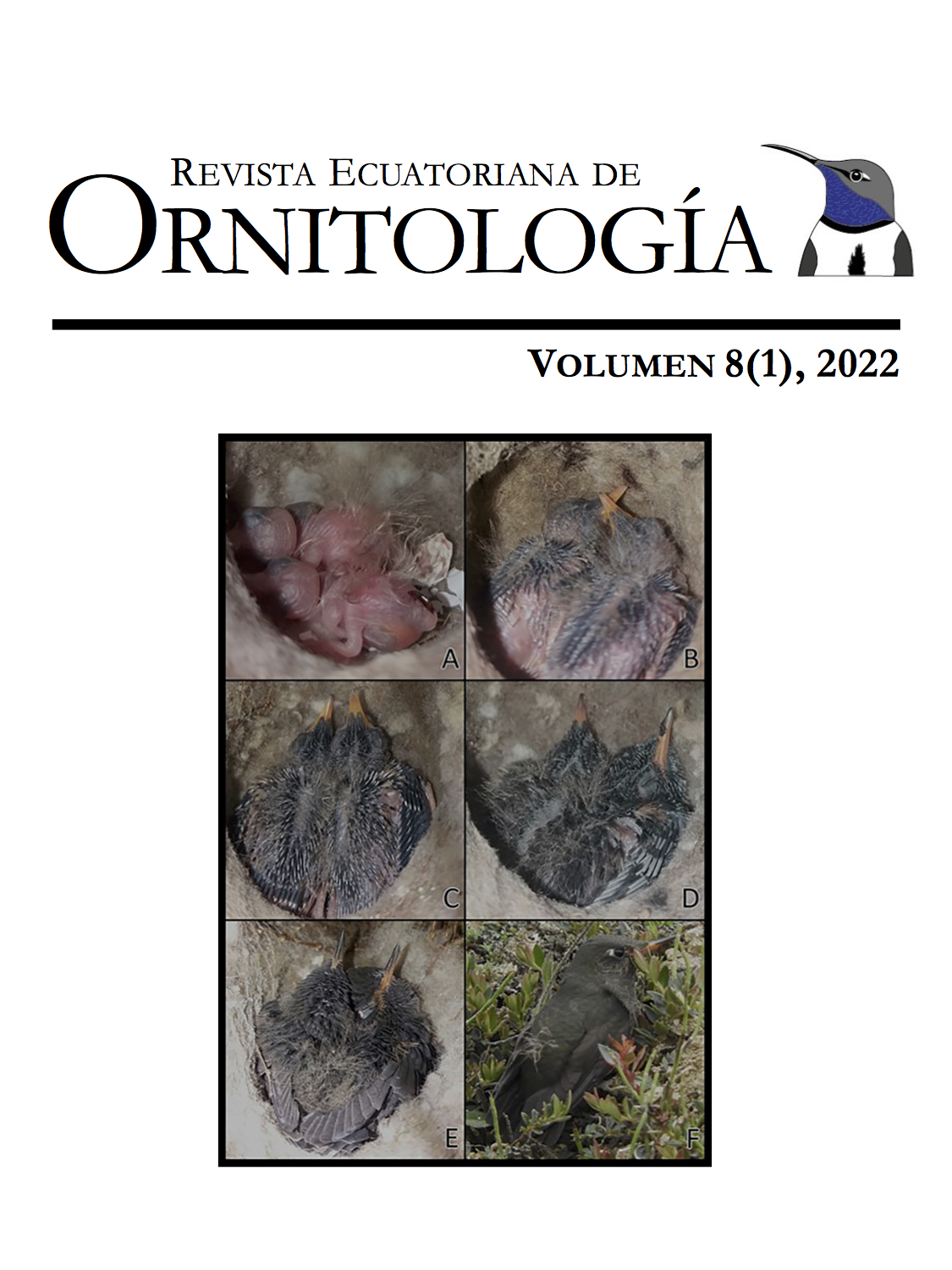PICOGRUESO AZUL Cyanocompsa parellina COMIENDO FLORES DE Tridax procumbens
DOI:
https://doi.org/10.18272/reo.v8i1.2422Palabras clave:
Colorín Azulnegro; dieta; Jalisco; México; saponinas esteroidalesResumen
Se documenta fotográficamente el primer registro de forrajeo de la Hierba de San Juan, Tridax procumbens, por el Picogrueso Azul, Cyanocompsa parellina. La captura fotográfico se realizó en Careyes, localidad del Pacífico mexicano en la costa sur del estado de Jalisco.
Descargas
Citas
Alden, P. (1969). Finding the birds in western Mexico: a guide to the states of Sonora, Sinaloa, & Nayarit. Tucson: The University of Arizona Press.
Arizmendi, M. C., Márquez-Valdelamar, L., & Ornelas, J. F. (2002). Avifauna de la región de Chamela, Jalisco. En: F.A. Noguera, J.H. Vega Rivera, A.N. García Aldrete & M. Quesada Avendaño (Eds), Historia Natural de Chamela. México: Instituto de Biología, Universidad Nacional Autónoma de México.
Bello-Cano, R. (2011). Bosque urbano, un lugar para convivir con la naturaleza. CienciaUAT, 5(4), 45−48. URL: https://www.redalyc.org/pdf/4419/441942924003.pdf
Brewer, D. (2021, Diciembre 01). Blue Bunting (Cyanocompsa parellina). Version 1.0. En: J. del Hoyo, A. Elliott, J. Sargatal, D. A. Christie, & E. de Juana (Eds), Birds of the World. Ithaca, NY: Cornell Lab of Ornithology. DOI: https://doi.org/10.2173/bow.blubun.01
Burgess, K. H. (1991). Florivory: The ecology of flower feeding insects and their host plants (Tesis de Doctorado). Harvard University, Cambridge, Massachusetts, Estados Unidos. URL: https://www.proquest.com/docview/303928843?pq-origsite=gscholar&fromopenview=true
Francis, G., Kerem, Z., Makkar, H. P. S., & Becker, K. (2002). The biological action of saponins in animal systems: a review. British Journal of Nutrition, 88, 587-605. DOI: http://www.dx.doi.org/10.1079/BJN2002725
Gargiullo, M.B., Magnuson, B., & Kimball, L. (2008). A field guide to plants of Costa Rica. Oxford: Oxford University Press.
Gonsioroski, G., Sazima, I., Silva, M. A. R., & Ubaid, F. K. (2021). Blooming meal: flower eating by the Blue-crowned Trogon Trogon curucui. Biota Neotropica, 21(3), e20201154. DOI: https://doi.org/10.1590/1676-0611-BN-2020-1154.
Holm, L., Doll, J., Holm, E., Pancho, J. V., & Herberger J. P. (1997). World weeds: Natural histories and distribution. New York: John Wiley and Sons.
Howell, S. N. G., & Webb, S. (1995). A guide to the birds of Mexico and northern Central America. Oxford: Oxford University Press.
Hutto, R. L., Hendricks, P., & Pletschet, S. (1985). Un censo invernal de las aves de la Estación de Biología Chamela, Jalisco, México. Anales del Instituto de Biología de la Universidad Nacional Autónoma de México, Serie Zoología, 56(3), 945−954. URL: http://cas.umt.edu/facultydatabase/FILES_Faculty/888/13_1985-Huttoetal-aibunam-chamela.pdf
Ishaaya, I., Birk, Y., Bondi, A., & Tencer, Y. (1969). Soyabean saponins IX. - Studies of their effect on birds, mammals and cold-blooded organisms. Journal of the Science of Food and Agriculture, 20(7), 433−436. DOI: http://www.dx.doi.org/10.1002/jsfa.2740200716.
Iyasere, O. S., Sodipo, T. O., & Subulokun, A. V. (2016). Effect of nutritional enrichment with forage (Tridax procumbens) on the behavior and growth performance of conventionally reared broiler chickens. Nigerian Journal of Animal Production, 43(1), 129−135. URL: https://www.ajol.info/index.php/njap/article/view/134326
Kpodekon, T. M., Dougnon, T. J., Goussanou, J. S. E., & Boko, C. (2015). Tridax procumbens effects on lesions, haematology and eggs production of hens affected by fowlpox. International Journal of Medical and Pharmaceutical Case Reports, 5(2): 1−9. DOI: https://doi.org/10.9734/IJMPCR/2015/18910
Palacios-Mosquera, Y., Mondragón, D., & Santos-Moreno, A. (2019). Vertebrate florivory of vascular epiphytes: the case of a bromeliad. Brazilian Journal of Biology, 79(2), 201−207. DOI: https://doi.org/10.1590/1519-6984.176023
Peterson, R. T., & Chalif, E. L. (1989). Aves de México: guía de campo. México: Editorial Diana.
Saxena, V. K., & Albert, S. (2005). B-Sitosterol-3-O-B-D-xylopyranoside from the flowers of Tridax procumbens Linn. Journal of Chemical Science, 117(3), 263−266. DOI: https://doi.org/10.1007/BF02709296
Sibley, D. A. (2000). National Audubon Society: The Sibley guide to birds. New York: Alfred A. Knopf.
Descargas
Publicado
Cómo citar
Número
Sección
Licencia
Los autores que publiquen en la Revista Ecuatoriana de Ornitología aceptan los siguientes términos:
- Los autores/as conservarán sus derechos de autor y garantizarán a la revista el derecho de primera publicación de su obra, el cuál estará simultáneamente sujeto a la Licencia de Reconocimiento No Comercial de Creative Commons.
- Los autores/as podrán adoptar otros acuerdos de licencia no exclusiva de distribución de la versión de la obra publicada, pudiendo de esa forma publicarla en un volumen monográfico o reproducirla de otras formas, siempre que se indique la publicación inicial en esta revista.
- Se permite y se recomienda a los autores difundir su obra a través de Internet en su repositorio institucional, página web personal, o red social científica (como ResearchGate o Academia.edu).



